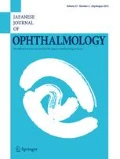Abstract
Purpose
We report the case of a patient with acute bilateral transient myopia, secondary angle-closure glaucoma, and choroidal detachment associated with oral administration of methazolamide.
Case
A 51-year-old man developed bilateral transient myopia and secondary angle-closure glaucoma with choroidal detachment after oral administration of methazolamide. Both eyes presented a shallow anterior chamber and elevated intraocular pressure. Ultrasound biomicroscopy revealed annular ciliochoroidal effusion and diffuse thickening of the ciliary body. Angiography showed many scattered islands of hypofluorescence in both eyes.
Observations
Methazolamide was stopped and prednisolone given orally. Eight days after treatment initiation, clinical symptoms and signs had resolved. The abnormal findings on ultrasound biomicroscopy and angiography disappeared by 2 months.
Conclusions
Methazolamide can induce bilateral transient myopia, angle-closure glaucoma, and choroidal detachment. Prompt identification of the causative medications and subsequent discontinuation can induce rapid resolution of angle closure.


Similar content being viewed by others
References
Lee GC, Tam CP, Danesh-Meyer HV, Myers JS, Katz LJ. Bilateral angle closure glaucoma induced by sulphonamide-derived medications. Clin Experiment Ophthalmol. 2007;35:55–8.
Panday VA, Rhee DJ. Review of sulfonamide-induced acute myopia and acute bilateral angle-closure glaucoma. Compr Ophthalmol Update. 2007;8:271–6.
Raffaele M, Chiara V, Angelica C, Francesco A, Carlo N. Acute bilateral angle-closure glaucoma and choroidal effusion associated with acetazolamide administration after cataract surgery. J Cataract Refract Surg. 2011;37:415–7.
Parthasarathi S, Myint K, Singh G, Mon S, Sadasivam P, Dhillon B. Bilateral acetazolamide-induced choroidal effusion following cataract surgery. Eye. 2007;21:870–2.
Ikeda N, Ikeda T, Nagata M, Minura O. Pathogenesis of transient high myopia after blunt eye trauma. Ophthalmology. 2002;109:501–7.
Ikeda N, Ikeda T, Nagata M, Mimura O. Ciliochoroidal effusion syndrome induced by sulfa derivatives. Arch Ophthalmol. 2002;120:1775.
Author information
Authors and Affiliations
Corresponding author
About this article
Cite this article
Kwon, S.J., Park, D.H. & Shin, J.P. Bilateral transient myopia, angle-closure glaucoma, and choroidal detachment induced by methazolamide. Jpn J Ophthalmol 56, 515–517 (2012). https://doi.org/10.1007/s10384-012-0159-y
Received:
Accepted:
Published:
Issue Date:
DOI: https://doi.org/10.1007/s10384-012-0159-y




